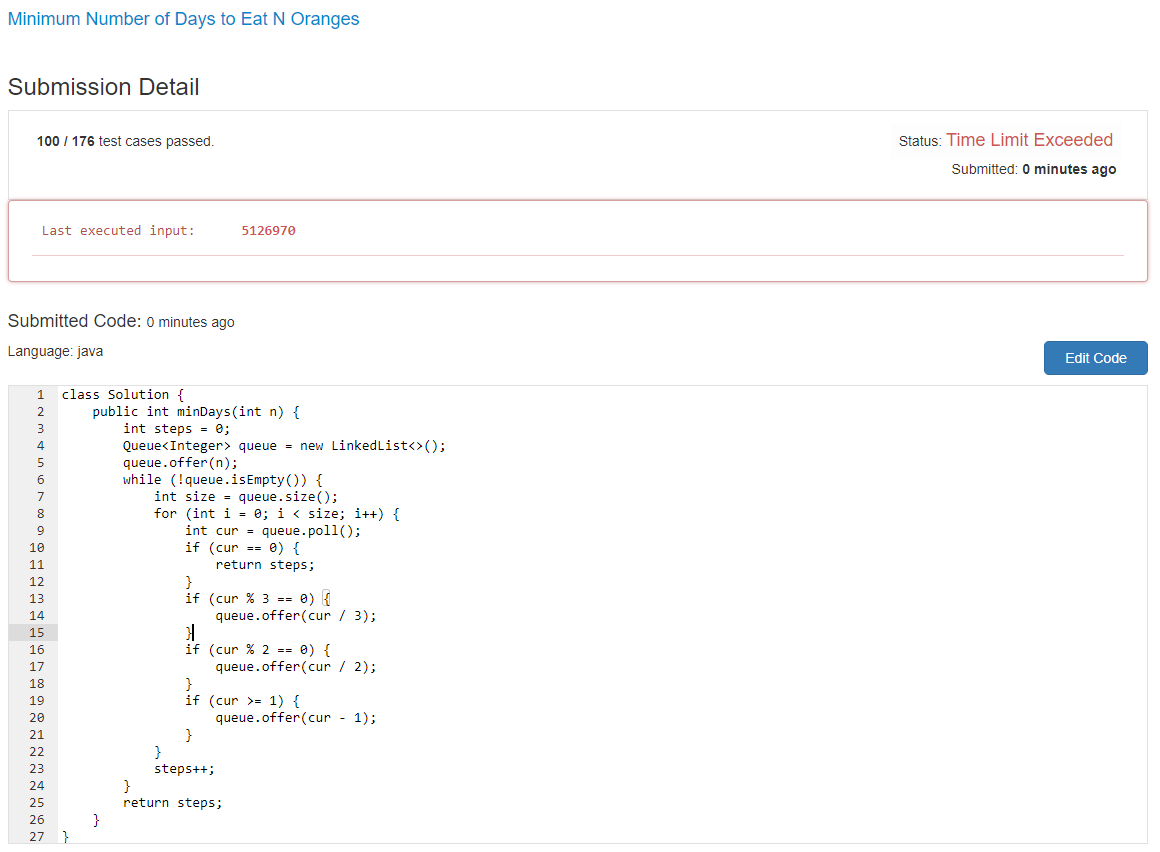There are n oranges in the kitchen and you decided to eat some of these oranges every day as follows:
- Eat one orange.
- If the number of remaining oranges (
n) is divisible by 2 then you can eat n/2 oranges. - If the number of remaining oranges (
n) is divisible by 3 then you can eat 2*(n/3) oranges.
You can only choose one of the actions per day.
Return the minimum number of days to eat n oranges.
Example 1:
Input: n = 10 Output: 4 Explanation: You have 10 oranges. Day 1: Eat 1 orange, 10 - 1 = 9. Day 2: Eat 6 oranges, 9 - 2*(9/3) = 9 - 6 = 3. (Since 9 is divisible by 3) Day 3: Eat 2 oranges, 3 - 2*(3/3) = 3 - 2 = 1. Day 4: Eat the last orange 1 - 1 = 0. You need at least 4 days to eat the 10 oranges.Example 2:
Input: n = 6 Output: 3 Explanation: You have 6 oranges. Day 1: Eat 3 oranges, 6 - 6/2 = 6 - 3 = 3. (Since 6 is divisible by 2). Day 2: Eat 2 oranges, 3 - 2*(3/3) = 3 - 2 = 1. (Since 3 is divisible by 3) Day 3: Eat the last orange 1 - 1 = 0. You need at least 3 days to eat the 6 oranges.Example 3:
Input: n = 1 Output: 1Example 4:
Input: n = 56 Output: 6
Constraints:
1 <= n <= 2*10^9
吃掉N个橘子的最少天数。
题意是给一个数字N代表橘子的个数,现在有三种吃法,每次吃橘子的时候你只能选择一种吃法。请问如何吃才能尽快吃完橘子,吃的次数最少。吃法如下,
- 吃掉一个橘子。
- 如果剩余橘子数 n 能被 2 整除,那么你可以吃掉 n/2 个橘子。
- 如果剩余橘子数 n 能被 3 整除,那么你可以吃掉 2*(n/3) 个橘子。
这个题我一开始做的时候试着用贪心的思路。因为乍一看如果橘子数量很大而且剩余橘子数量能被 3 整除的话,一直选择第三种吃法似乎是最快的;如果剩余橘子数量不能被 3 整除,则试试看能不能被 2 整除;如果再不行则试着只吃掉一个橘子。这个思路会超时。
一个能通过的思路是 BFS。每次判断的时候,三种方法都试一下,将三种方法吃剩下的橘子数放入 queue,就跟树的层序遍历一样。如此遍历,最后看看需要几轮能把橘子吃完,返回那个轮数。这样常规地做 BFS 思路是没问题,但是依然会超时。

既然常规的 BFS 会超时,同时发现其实有一些中间结果是重复出现的,那么就试着用一个 hashset 记录一下中间结果。如果再次出现,则直接跳过,不需要再次放入 queue。
时间O(n)
空间O(n)
Java实现
1 class Solution { 2 public int minDays(int n) { 3 int steps = 0; 4 Queue<Integer> queue = new LinkedList<>(); 5 queue.offer(n); 6 HashSet<Integer> set = new HashSet<>(); 7 while (!queue.isEmpty()) { 8 int size = queue.size(); 9 for (int i = 0; i < size; i++) { 10 int cur = queue.poll(); 11 if (set.contains(cur)) { 12 continue; 13 } 14 set.add(cur); 15 if (cur == 0) { 16 return steps; 17 } 18 if (cur % 3 == 0) { 19 queue.offer(cur / 3); 20 } 21 if (cur % 2 == 0) { 22 queue.offer(cur / 2); 23 } 24 if (cur >= 1) { 25 queue.offer(cur - 1); 26 } 27 } 28 steps++; 29 } 30 return steps; 31 } 32 }